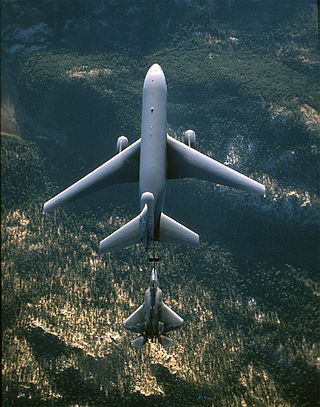
The 6th Air Refueling Squadron is part of the 60th Air Mobility Wing at Travis Air Force Base, California. It operates the McDonnell Douglas KC-10 Extender aircraft conducting mobility, and air refueling missions.

The 70th Air Refueling Squadron is an Air Force Reserve Command unit, assigned to the 349th Operations Group at Travis Air Force Base, California. It is an associate of the active duty 9th Air Refueling Squadron, United States Air Force, and operates the McDonnell Douglas KC-10 Extender aircraft conducting mobility, and air refueling missions. The squadron has served in this role since 1994.

The 350th Air Refueling Squadron is a United States Air Force unit assigned to the 22nd Air Refueling Wing at McConnell Air Force Base, Kansas. It operates Boeing KC-135 Stratotanker aircraft conducting air refueling missions.

The 530th Combat Crew Training Squadron is an inactive United States Air Force unit. It was last assigned to the 380th Bombardment Wing at Plattsburgh Air Force Base, New York, where it was inactivated on 1 July 1991.

The 418th Flight Test Squadron is a United States Air Force squadron. It is assigned to the 412th Operations Group, Air Force Materiel Command, stationed at Edwards Air Force Base, California.

The 531st Bombardment Squadron was a unit of the US Air Force, first activated during World War II. After training as a heavy bomber unit in the United States, it moved to the Southwest Pacific Theater, entering combat in May 1943, flying combat missions from Australia while attached to the Royal Australian Air Force, earning two Distinguished Unit Citations and a Philippine Presidential Unit Citation. In 1945 it moved forward to the Philippines, then to Okinawa. Following V-J Day, the squadron returned to the Philippines and was inactivated there in February 1946.

The 384th Air Expeditionary Group is a provisional United States Air Force unit assigned to the Air Combat Command. The 384 AEG may be activated or inactivated at any time.

The 544th Bombardment Squadron is an inactive United States Air Force unit. It was last assigned to the 384th Bombardment Wing at Little Rock Air Force Base, Arkansas, where it was inactivated on 1 September 1964.

The 545th Bombardment Squadron is an inactive United States Air Force unit. It was last assigned to the 384th Bombardment Wing at Little Rock Air Force Base, Arkansas, where it was inactivated on 1 September 1964.

The 546th Bombardment Squadron is an inactive United States Air Force unit. It was last assigned to the 384th Bombardment Wing at Little Rock Air Force Base, Arkansas, where it was inactivated on 1 September 1964.

The 513th Electronic Warfare Squadron is a United States Air Force unit assigned to the 350th Spectrum Warfare Group at Eglin Air Force Base, Florida.

The 339th Bombardment Squadron is an inactive United States Air Force unit. It was last assigned to the 96th Bombardment Wing at Dyess Air Force Base, Texas, where it was inactivated on 15 March 1963.

The 487th Bombardment Squadron is an inactive United States Air Force unit. It was last assigned to the 340th Bombardment Wing at Whiteman Air Force Base, Missouri, where it was inactivated on 1 September 1963. The squadron was first activated during World War II. After training in the United States, it deployed to the Mediterranean Theater of Operations, where it flew North American B-25 Mitchell medium bombers, primarily on air support and air interdiction missions, earning two Distinguished Unit Citations for its actions. After V-E Day, the squadron returned to the United States, where it was inactivated in November 1945.

The 424th Bombardment Squadron is an inactive United States Air Force unit. Its last assignment was with the 307th Bombardment Wing at Lincoln Air Force Base, Nebraska, where it was inactivated on 1 January 1962.

The 338th Combat Crew Training Squadron is a currently inactive United States Air Force unit. It was last assigned to the 96th Operations Group at Dyess Air Force Base, Texas, where it was inactivated on October 1, 1993.

The 352d Bombardment Squadron is an inactive United States Air Force unit. It was last assigned to the 301st Bombardment Wing at Lockbourne Air Force Base, Ohio, where it was inactivated on 8 June 1964.

The 347th Bombardment Squadron is an inactive United States Air Force unit. It was last assigned to the 4047th Strategic Wing, and was inactivated at McCoy Air Force Base, Florida on 1 April 1963.

The 346th Test Squadron is a United States Air Force unit assigned to the 318th Cyberspace Operations Group at Joint Base San Antonio–Lackland, Texas. The squadron tests military cyberspace operation systems.

The 365th Bombardment Squadron is an inactive United States Air Force unit. It was first activated in March 1942. After training with Boeing B-17 Flying Fortress bombers in the United States, the squadron deployed to the European Theater of Operations, where it participated in the strategic bombing campaign against Germany. The squadron was twice awarded the Distinguished Unit Citation for its combat actions. Following V-E Day, it moved to the continent of Europe and engaged in photographic mapping until inactivating in December 1946.

The 96th Test Wing is a United States Air Force unit assigned to the Air Force Test Center of Air Force Materiel Command at Eglin Air Force Base, Florida. The wing was activated at Eglin in 1994 as the 96th Air Base Wing, the headquarters for all support units on Eglin, the largest installation in the Air Force. In 2012, it absorbed the mission and resources of the 46th Test Wing and added the mission of testing and evaluating weapons, navigation and guidance systems and command and control systems.
























